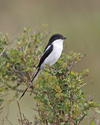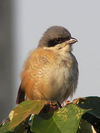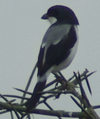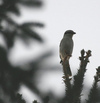Genus Lanius
Bull-headed Shrike - It is 19-20 cm long. The male has a brown crown, white eyebrow and black mask. The back is grey-brown while the wings are dark with a white patch. The flanks are rufous and the rest of the underparts are whitish with fine barring. Females are similar but duller and browner with a brown mask and no white wing-patch. The species has harsh grating and chattering calls and will also mimic other birds.
Fiscal Shrike - This is a fairly distinctive 21–-23 cm long passerine with white underparts and black upperparts extending from the top of the head down to the tail. The bird has a characteristic white 'V' on the back and a relatively long black tail with white outer feathers and white tips on the other feathers. The bill, eyes and legs are black. Adult male and female Common Fiscals are quite similar except for the rufous lower flank of the female. A western race is distinct in showing a clear white eyebrow.
Red-backed Shrike - This bird breeds in most of Europe and western Asia and winters in tropical Africa. Its range is contracting, and it is now probably extinct in Great Britain as a breeding bird, although it is frequent on migration. It is named as a protected bird in Britain under a Biodiversity Action Plan. It breeds in open cultivated country with hawthorn and dog rose.
Burmese Shrike - The Burmese Shrike is a species of bird in the Laniidae family. It is found in Bangladesh, Cambodia, China, India, Laos, Myanmar, Thailand, and Vietnam. Its natural habitats are subtropical or tropical moist lowland forests and subtropical or tropical moist montanes.
Brown Shrike - This shrike is mainly brown on the upper parts and the tail is rounded. The black mask can be paler in winter and has a white brow over it. The underside is creamy with rufous flanks and belly. The wings are brown and lack any white mirror patches. Females have fine scalloping on the underside and the mask is dark brown and not as well marked as in the male. Subspecies lucionensis has a grey crown shading into the brown upperparts and the rump appears more rufous than the rest of the upperback.
Butcher-bird - The Great Grey Shrike or Northern Grey Shrike is a large songbird species in the shrike family . It breeds generally north of 50° northern latitude in northern Europe and Asia, and in North America north of 55° northern latitude in Canada and Alaska. Most populations migrate south in winter to temperate regions.
Emin's Shrike - The Emin's Shrike is a species of bird in the Laniidae family. It is found in Cameroon, Central African Republic, Democratic Republic of the Congo, Ivory Coast, Ghana, Guinea-Bissau, Mali, Nigeria, Sudan, and Uganda. Its natural habitat is dry savanna.
Rufous-tailed Shrike - The Isabelline Shrike breeds in south Siberia and central Asia and China ) and winters in the tropics. These two races are sometimes regarded as separate species. It is a rare vagrant to western Europe, including Great Britain, usually in autumn.
French mockingbird - The bird has a large hooked bill; the head and back are grey and the underparts white. The wings and tail are black, with white patches on the wings and white on the outer tail feather. The black face mask extends over the bill, unlike that of the similar but slightly larger Northern Shrike.
Mackinnon's Shrike - It is found in Angola, Burundi, Cameroon, Republic of the Congo, Democratic Republic of the Congo, Equatorial Guinea, Gabon, Kenya, Nigeria, Rwanda, Tanzania, and Uganda.
Lesser Grey Shrike - It is similar in appearance to the Great Grey Shrike Lanius excubitor and the Southern Grey Shrike L. meridionalis. It breeds in southeastern Europe and into Asia.
Newton's Fiscal - The species lives on the island of São Tomé and is usually found under closed canopy. Its natural habitats are subtropical or tropical moist lowland forests and subtropical or tropical moist montanes.
Masked Shrike - Since this is a short-range migrant, a bird in Scotland in October 2004 was a remarkable example of vagrancy, though a second British record occurred on St. Mary's in the Isles of Scilly in November 2006.
Rufous-backed Shrike - It is a common resident breeder throughout the Indomalayan ecozone from Kazakhstan, through Afghanistan, Pakistan, Indian peninsula except eastern states, to New Guinea, found on bushes in scrubby areas and cultivation. Winter visitor to southern areas such as southeast India and Sri Lanka.
Woodchat Shrike - The Woodchat breeds in southern Europe, the Middle East and northwest Africa, and winters in tropical Africa. It breeds in open cultivated country, preferably with orchard trees and some bare or sandy ground.
Somali Fiscal - The Somali Fiscal is a species of bird in the Laniidae family. It is found in Djibouti, Ethiopia, Kenya, and Somalia. Its natural habitat is subtropical or tropical dry shrubland.
Sousa's Shrike - The Souza's Shrike is a species of bird in the Laniidae family. It is found in Angola, Botswana, Republic of the Congo, Democratic Republic of the Congo, Gabon, Malawi, Mozambique, Namibia, Rwanda, Tanzania, and Zambia. Its natural habitat is dry savanna.
Tiger Shrike - It derives its name from the tiger-like pattern of its upperparts which are reddish-brown with dark bars. Adult males have white underparts and a grey head with a black mask. Females and young birds are duller and browner and young birds lack the grey and black on the head.
Gray-capped Shrike - Its natural habitats are subtropical or tropical moist lowland forests and subtropical or tropical moist montane forests. It is becoming rare due to habitat loss.
Bay-backed Shrike - It is smallish shrike at 17 cm, maroon-brown above with a pale rump and long black tail with white edges. The underparts are white, but with buff flanks.

















